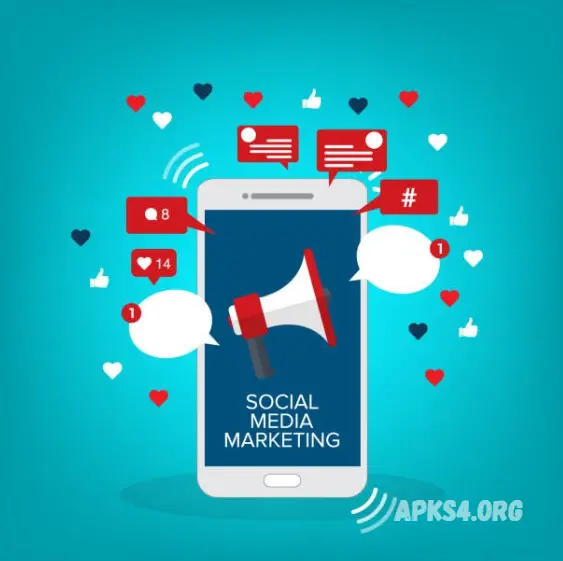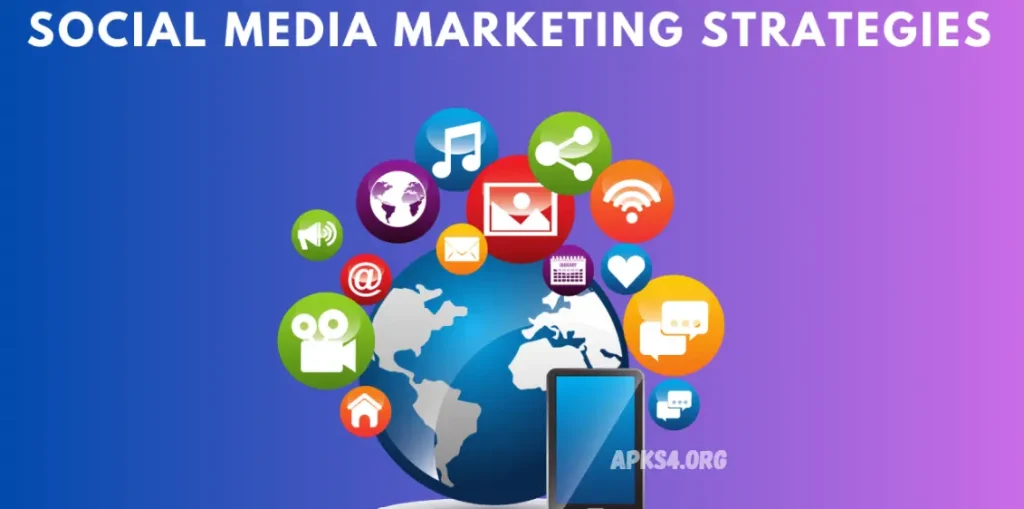Social media marketing (SMM) has emerged as a powerful tool for businesses aiming to enhance their brand presence in today’s digital landscape. With its broad reach and dynamic capabilities, SMM offers an effective platform for engaging with audiences, increasing brand awareness, and promoting products or services. This article delves into the ways in which social media marketing can drive brand growth and outlines key strategies for achieving success in this ever-evolving space.
The Importance of Social Media Marketing

Social media marketing (SMM) has become an essential component of any successful business strategy. With billions of active users across various platforms, social media offers unparalleled opportunities to connect with target audiences, build brand loyalty, and drive business growth.
Here are some key reasons why social media marketing is crucial for businesses:
1. Wider Reach and Increased Visibility
Social media platforms like Facebook, Instagram, Twitter, LinkedIn, and TikTok offer businesses the ability to reach a global audience. Whether you are a local startup or an international brand, these platforms allow you to connect with potential customers and expand your visibility far beyond traditional marketing channels.
2. Cost-Effective Advertising
Compared to traditional forms of advertising, social media marketing is often more affordable and provides a higher return on investment (ROI). With options like paid ads, promoted posts, and influencer partnerships, businesses can tailor their campaigns to specific demographics, ensuring their budget is used efficiently.
3. Enhanced Customer Engagement
Social media provides a direct and interactive way to engage with customers. Businesses can respond to inquiries, address concerns, and gather feedback in real time. This two-way communication fosters stronger relationships with customers, building trust and brand loyalty.
4. Targeted Marketing
One of the most powerful features of social media marketing is its ability to target specific audience segments based on demographics, interests, behaviors, and geographic location. This level of precision ensures that marketing messages are reaching the right people at the right time, leading to higher conversion rates.
5. Brand Authority and Credibility
Consistent and meaningful engagement on social media helps establish your brand as an authority in your industry. By sharing valuable content, responding to customer comments, and participating in relevant conversations, businesses can build trust and credibility with their audience.
6. Valuable Insights and Analytics
Social media platforms provide businesses with detailed analytics and performance metrics. By analyzing these insights, brands can gain a deeper understanding of customer behavior, preferences, and engagement patterns, enabling them to refine their marketing strategies and improve future campaigns.
7. Increased Traffic and Lead Generation
Social media channels are a powerful tool for driving traffic to your website, landing pages, or online stores. By including strategic calls-to-action, sharing valuable content, and running targeted ads, businesses can encourage users to take the next step, whether that’s making a purchase, signing up for a newsletter, or exploring additional products.
8. Real-Time Marketing Opportunities
Social media allows businesses to take advantage of trending topics, real-time events, and viral content. By staying active and adaptable, brands can capitalize on these opportunities to increase their visibility and relevance in the market.
The Quality and Consistency of Content
A key factor in achieving success with social media marketing is the creation of consistent, high-quality content. Every post you share should be meaningful, relevant, and valuable to your audience. While promoting your product is essential, it’s not necessary to focus on direct sales in every post. Instead, offering industry-related tips, insights, or educational content can help establish trust and position your brand as a valuable resource. Consistency in posting is also vital; without regular updates, your brand risks being forgotten by your audience.
The Power of Visual Content
Visual content is the most compelling form of engagement on social media. Images, videos, and infographics are crucial for capturing attention and conveying messages effectively. Platforms like Instagram and Pinterest are particularly visual-centric, making them ideal spaces to showcase high-quality photos and engaging videos. By sharing visually striking content, you not only attract attention but also leave a lasting impression. Visuals are more memorable and impactful and tend to generate higher engagement rates, making them an indispensable part of your social media strategy.
Leverage Influencer Marketing

Influencer marketing has become a cornerstone of successful social media strategies. Influencers—individuals with a large, engaged following on social platforms—can play a pivotal role in amplifying your brand’s visibility. Collaborating with influencers who align with your brand values and target audience allows you to tap into their established credibility and reach. When influencers share your product or service with their followers, they can effectively introduce your brand to new potential customers, driving awareness and, ultimately, conversions.
The Power of Engagement and Interaction
One of the most significant advantages of social media is the opportunity for direct interaction with your audience. Engaging with your followers allows you to respond to inquiries, gather valuable feedback, and participate in ongoing conversations. This level of communication builds trust and strengthens relationships with your customer base. When customers see that your brand is attentive to their needs and responsive to their concerns, they are more likely to develop loyalty and become long-term advocates for your brand.
Visit now: Content Marketing Strategies for Small Businesses
Strategic Use of Hashtags
Hashtags, when used strategically, can significantly enhance the reach of your social media content. These keywords or phrases help categorize content and make it discoverable by users who are interested in specific topics, trends, or themes. By incorporating relevant and popular hashtags into your posts, you can increase the visibility of your content, broaden your audience, and attract new followers who are aligned with your brand’s message. Proper hashtag usage is a powerful tool for expanding your social media presence and engaging with a wider community.
Take Advantage of Social Media Ads
In addition to organic reach, paid social media advertising is a powerful way to boost your brand’s visibility. Platforms such as Facebook, Instagram, and LinkedIn offer targeted ad options that allow you to reach your ideal audience with precision. These platforms enable you to tailor your ads based on specific demographics, interests, behaviors, and geographic location, ensuring your message reaches the most relevant individuals. Paid ads can complement your organic efforts, driving immediate results and helping you expand your brand’s presence in a competitive digital landscape.
Harnessing the Power of Data Analytics and Insights
Social media platforms provide valuable data and insights that can enhance the effectiveness of your campaigns. By tracking key metrics, you can assess which posts resonate most with your audience, identify optimal posting times, and understand the demographics of your followers. Analyzing this data helps you fine-tune your strategy, optimize content performance, and make data-driven decisions that improve your overall social media marketing efforts.
Monitoring and Analyzing the Competition
A crucial aspect of social media marketing is keeping a close eye on your competition. By observing how competitors promote their products and the strategies they employ, you can gain valuable insights into what works and what doesn’t in your industry. Analyzing their successful campaigns can inspire new ideas for your own marketing efforts, while identifying areas where they fall short gives you an opportunity to differentiate your brand. Understanding the competitive landscape is key to carving out a unique position for your business and staying ahead in the market.
Benefit from User-Generated Content
User-generated content (UGC) is an incredibly valuable asset for your brand. This includes content created by your customers or followers, such as product reviews, testimonials, or images showcasing your product in use. UGC is perceived as more authentic and relatable, which can help attract new audiences who trust peer recommendations over traditional advertising. Encouraging your followers to share their experiences with your brand and featuring their content on your social media channels not only builds trust but also fosters a sense of community and loyalty.
Leveraging Social Media for Customer Support and Feedback
Social media has evolved beyond a marketing tool—it has become an essential channel for customer support. It enables you to respond quickly to inquiries, resolve issues, and address complaints in real-time. This level of responsiveness fosters a positive image of your brand, demonstrating that you value customer satisfaction. Additionally, engaging with your audience in this way allows you to gather valuable feedback, which can be used to refine your products and services, driving long-term growth and improving the overall customer experience.
Staying on Top of Social Media Trends
Social media trends are ever-changing, and staying current with them is crucial for keeping your brand relevant and engaging. Whether it’s participating in viral challenges, leveraging meme culture, or adopting new features on platforms, staying on top of trends allows you to connect with your audience in fresh, timely ways. When used appropriately, trends can help boost engagement and visibility, but it’s essential to ensure they align with your brand’s voice and values to maintain authenticity.
Implementing a Cross-Platform Strategy
In today’s digital landscape, a cross-platform strategy is essential for reaching a broader audience. Focusing solely on one platform may limit your brand’s potential. Instead, you should have a presence on multiple social media platforms—such as Facebook, Instagram, Twitter, LinkedIn, and TikTok—to take advantage of the unique audiences each platform offers. By tailoring your content to suit the specific features and user base of each platform, you can maximize engagement and broaden your reach across diverse demographics.
Developing a Long-Term Social Media Strategy
Success in social media marketing is a marathon, not a sprint. It requires a long-term approach with consistency and adaptability. Regularly assessing your strategy and adjusting it based on performance data and changing trends is essential for sustainable growth. A well-thought-out, long-term plan ensures that your brand continues to expand, maintaining momentum and fostering deeper connections with your audience over time.
Frequently Asked Questions
Why is social media marketing important for my business?
Social media marketing allows businesses to reach a larger, more targeted audience, engage with customers directly, and build brand awareness. It’s a cost-effective way to advertise, gather feedback, and foster customer loyalty. In today’s digital world, a strong social media presence is essential for staying competitive and relevant.
How can I grow my brand on social media?
To grow your brand on social media, focus on creating high-quality, engaging content that resonates with your target audience. Consistency is key—regularly post valuable content, engage with your followers, and adapt your strategy based on performance data. Collaborating with influencers, utilizing paid advertising, and using visual content can also amplify your reach.
What type of content should I post on social media?
Your content should be a mix of informative, entertaining, and promotional material. While product promotions are essential, you should also focus on sharing industry insights, tips, and user-generated content to build trust with your audience. The key is to provide value without overwhelming your followers with constant sales messages.
How often should I post on social media?
Posting frequency depends on the platform and your audience. For platforms like Instagram and Facebook, aim to post at least 3-5 times per week. On Twitter, 5-10 posts per week can keep your brand visible. However, quality should always take precedence over quantity—ensure your posts are meaningful, timely, and engaging.
What role does influencer marketing play in brand growth?
Influencer marketing can significantly boost brand visibility and credibility. Collaborating with influencers who have a strong following in your niche can introduce your brand to new audiences and build trust. Influencers’ authentic recommendations can drive conversions and create lasting connections with potential customers.
How do I measure the success of my social media campaigns?
Key performance indicators (KPIs) such as engagement rates, reach, impressions, website traffic, and conversions are essential for measuring the effectiveness of your social media campaigns. Most social media platforms provide analytics tools to track these metrics, helping you understand what content performs best and where to focus your efforts.
How can I use data and insights to improve my strategy?
Data and analytics provide a wealth of information on audience behavior, content performance, and campaign effectiveness. By analyzing metrics like post engagement, click-through rates, and demographic data, you can identify trends, optimize your content, and refine your targeting strategy to improve results over time.
What are the best platforms for my business?
The best platforms for your business depend on your industry, target audience, and content type. Instagram, Facebook, and TikTok are ideal for B2C brands, especially those with visual products. LinkedIn is best for B2B companies and professionals, while Twitter is great for real-time updates and conversations. Research where your audience spends the most time and focus your efforts there.
Conclusion
Social media marketing is not just a trend—it has become an essential strategy for businesses aiming to expand their reach, engage with customers, and build a strong brand presence in today’s digital-first world. By leveraging platforms like Facebook, Instagram, LinkedIn, and Twitter, businesses can access a vast, diverse audience, allowing them to promote their products, foster loyalty, and drive conversions in cost-effective ways.
The key to success in social media marketing lies in a blend of high-quality content, consistent engagement, data-driven decision-making, and staying attuned to trends. Whether through user-generated content, influencer partnerships, or targeted ads, social media offers unparalleled opportunities to amplify your message and create meaningful connections with your audience.

